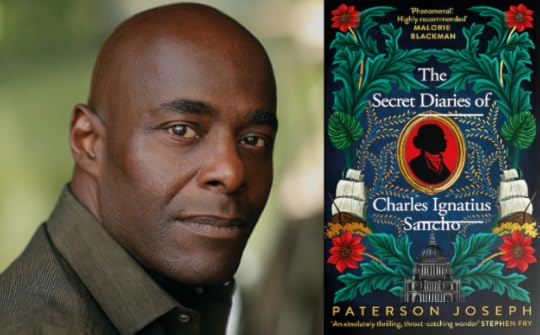‘The Secret Diaries of Charles Ignatius Sancho’ by Paterson Joseph — A book review.

What do I have to say about Paterson Joseph’s novel, The Secret Diaries of Charles Ignatius Sancho? A lot. Can I neatly and coherently articulate those things in a single blog post? Probably not, but I’m nothing if not a trier in life.
Firstly, for those yet to read the novel, a word on which format might suit your tastes. From my reader friends who are fans of audiobooks, I have had countless recommendations for the audiobook version of this novel.
Having now seen Joseph read excerpts of his book on stage, it is clear to me why.
A well-performed audiobook of a great novel produces an immersive reading experience like no other. I do not doubt that’s exactly what you’ll find with this one — the perfect format for readers wishing to intensely feel this story, and a great story it is. I shall be adding this to my audiobook tbr for a future ‘reread.’
Some matters, though, can be lost in translation when it comes to audiobooks, and to best appreciate narrative structuring, framing, symmetry or asymmetry, stylistic flourishes, prose style, diction, syntax etc., (if that’s your thing) I prefer to see the words on the page for myself.
For those who, consciously or unconsciously, derive personal satisfaction from the craftsmanship of good novels, this book will deliver.
This directs me towards the two things I’d like to focus upon for my review, the story or plot (which, in this context, we shall use interchangeably) and the craftsmanship of the novel.
Beginning then with the story. The Secret Diaries of Charles Ignatius Sancho, is a fictionalised narrative of a real story, the story of Ignatius Sancho — wit, reader, gentleman of letters, composer, husband, father, shop owner, and (we think) the first Black Briton to vote in an election.
Sancho was also born on a slave ship and shortly thereafter sent to spend his childhood as a sort of plaything/companion/servant for three sisters in Greenwich.
This remarkable life is the story Joseph retells in his fictionalised diaries and, for those who have read about the history of Sancho’s life and read Sancho’s own letters, Joseph remains close to the truth at all times.
For Joseph, his interest in Sancho’s story has been a deeply personal and decades-long obsession.
This, his debut novel, is far from his first venture into sharing Sancho’s story and it is doubtless that this longstanding closeness to a man who died almost 250 years ago has enabled Joseph to produce such an authentic and engaging character portrayal in his novel.
The story of this novel, the focal figure of this character-driven tale is that of the real Sancho — Joseph has taken an incomplete sketch and returned us a clearer, more vibrant image.
So, is that it, Joseph has produced a well-written, accurate and engaging work of historical fiction based on the life of Sancho? — I mean, yes, he has done that and if you appreciate good, close-to-truth historical fiction about interesting people, that is exactly what you’ll be getting from this book.
But I do think there’s more to this book than that and, for me, this is spoken through the framing of the narrative and the presence of ‘the implied author.’
Here we move into discussing the craftsmanship of the novel. To begin, Joseph frames Sancho’s story within his (Joseph’s) experience of Sancho.
Joseph begins and ends the novel with a dated address to the reader, starting his dialogue in September 2021 and ending it in June 2022. Joseph is a character in Sancho’s continued history and is, to some extent, a character in the novel also.
The ‘implied author’ — that is, an impression of Joseph that is left on the pages and between the lines of this novel, is remarkably clear. We must not confuse the narrator with the storyteller here. Sancho, or Joseph’s reincarnation of Sancho, is the primary narrator — telling his own tale in a first-person dialogue of diary entries, letters and writings to his son.
When a storyteller (in this case, Joseph) leaves a distinct impression of themselves throughout their text, in choices of style, diction, structure etc., and the themes and questions they leave imprinted on the story, they become a character in their own right; this is our ‘implied author’ and Joseph is implied in almost every line of this novel.
His choice to embrace a more complex and elegant prose style, his use of Dickensian-inspired descriptions, his choice to situate the story within a dialogue from father to son, his choice to close doors and drop hints and simply refuse to fill many of the blanks in Sancho’s story — all this characterises the storyteller.
Of course, the ‘implied author’ may have no likeness at all to the real human who wrote the book. Yet, in this case, I rather get the impression that, much like Sancho, the storyteller we meet in this novel is an authentic portrayal of the real man.
A final word on craftsmanship, and back to framing again. Anne, Sancho’s wife, narrates for no insignificant portion of this tale through her letters. This adds a third dimension of framing.
Initially, we are met with Sancho’s story, then Sancho’s story as it relates to Joseph’s experience of knowing Sancho, and finally, Sancho’s story as distilled within a moment of complex, sprawling, multidimensional British history: Black Britons during the age of British slavery.
Anne offers a glimpse at the dark and unpleasant world beyond Sancho’s narrow experience of slavery and the two worlds contrast significantly. Anne’s perspective broadens Sancho’s tale and enables the reader to place his individual experience within the wider narrative of the Black experience during Britain’s slave trade.
I could go on, but I won’t. I shall end things here by saying, a five-star read for me, that I’d recommend to all readers.
[image error]


